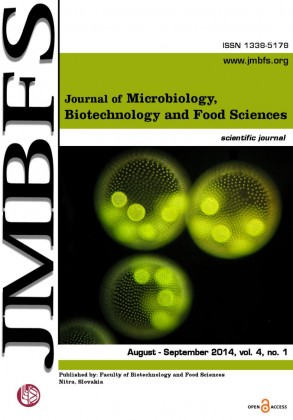FATTY ACID CONTENT IN BROILER´S ROSS 308 MEAT MUSCLES AFTER USING BEE POLLEN AND PROBIOTIC AS SUPPLEMENTARY DIET INTO THEIR FEED MIXTURE
DOI:
https://doi.org/10.15414/jmbfs.2014.4.1.67-69Keywords:
Broiler Ross 308, fatty acid, bee pollen, probiotic, monounsaturatedAbstract
The present experiment was aimed to study the effect of the bee pollen and probiotic on broiler´s meat fatty acid. A total of 120 one day old chicks, which were divided into 4 groups (n=30). Central, E1 (400 mg.kg-1 bee pollen), E2 (3.3 g probiotic) and E3 (400 mg.kg-1 bee pollen + 3.3 g probiotic) of complete feed mixture, the probiotic has been added through drinking water. After 42 days broiler has been slaughtered to determine meat fatty acid concentrations. We found that the probiotic was increased about (78.9%) of the essential fatty and bee pollen was increased about (68.4%) of essential fatty acid in the experimental groups and there were found significant differences (P≤0.05) in monounsaturated acid (MUFA), heptadecanoic acid and omega-6 between control and E1groups. The mixed between bee pollen and probiotic were reduce the content of the essential fatty acid. However, bee pollen and probiotic were decreased nonessential fatty acid in broiler meat muscles and they were found significant difference (P≤0.05) in saturated fatty acid (SFA) between control and E1, also between control and myristic acid. It was concluded that the bee pollen and probiotic have increased the fatty acid and decrease the non essential fatty acid in broiler meat muscles.Downloads
Download data is not yet available.
Downloads
Published
2014-08-01
How to Cite
HaÅ¡ÄÃk, P., Elimam, I., GarlÃk, J., Bobko, M., TkáÄová, J., Trembecká, L., & KaÄániová, M. (2014). FATTY ACID CONTENT IN BROILER´S ROSS 308 MEAT MUSCLES AFTER USING BEE POLLEN AND PROBIOTIC AS SUPPLEMENTARY DIET INTO THEIR FEED MIXTURE. Journal of Microbiology, Biotechnology and Food Sciences, 4(1), 67–69. https://doi.org/10.15414/jmbfs.2014.4.1.67-69
Issue
Section
Food Sciences
License
Copyright (c) 2014 Peter HaÅ¡ÄÃk, Ibrahim Elimam, Jozef GarlÃk, Marek Bobko, Jana TkáÄová, Lenka Trembecká, Miroslava KaÄániová

This work is licensed under a Creative Commons Attribution 4.0 International License.
All papers published in the Journal of Microbiology, Biotechnology and Food Sciences are published under a CC-BY licence (CC-BY 4.0). Published materials can be shared (copy and redistribute the material in any medium or format) and adapted (remix, transform, and build upon the material for any purpose, even commercially) with specifying the author(s).





